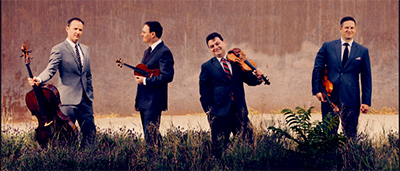by David Kulma

The Jerusalem Quartet — violinists Alexander Pavlovsky and Sergei Bresler, violist Ori Kam, and cellist Kyril Zlotnikov — play with remarkable tonal consistency. Each musician has a ringing tone, and together they achieve both a wonderful blend and a distinct character, keeping ears perked throughout. Their programming was traditional and well-designed to please those who love the great canonical works: the first half paired Beethoven’s joyful early quartet, Op. 18, No. 5 in A with Ravel’s luminous Quartet in F, while the second half featured Shostakovich’s Quartet No. 3 in F from 1946.
In the Beethoven quartet, the Jerusalem beautifully polished this mostly sunny music — which includes some surprising, dark turns. The group tended to amp up hushed passages with excellently tuned straight tones, which set these moments into high relief over the vibrant, singing lines. The Jerusalem shined in the slow movement, a theme and variations, which opened with a lovely, simple theme that brought to mind a forest picnic. After a bouncing solo from Pavlovsky, the pastoral mood added twittering trills before pivoting to a celebratory polka-band episode full of Zlotnikov’s vigorous boom-chucks. The lovely performance was well-judged both in timing and texture.
Ravel’s musical universe seemed worlds away from the Beethoven under the sure technical finesse of Pavlovsky, Bresler, Kam, and Zlotnikov. Their playing was immediately different: faster bows and a lighter touch, turning their instruments into fountains of color. The Jerusalem told a story in sound throughout, with energetic guitar-style plucking in the second movement, the suave yet enormously passionate slow third movement, and the agitated finale, with its kaleidoscopic array of sounds. The Quartet fully deserved the standing ovation following this music’s flying ending.
Over his adult life, Dmitri Shostakovich slowly turned the string quartet into his most personal medium. Given the generally dark and foreboding nature of his music, it’s hard to avoid reading one’s own politics into it. What terrible things can Shostakovich help us mourn? So it was that for me that his Third Quartet, played with leaden intensity by the Jerusalem, became a mirror of current sadness and rage.
The opening movement can seem lighthearted, but the constant tonal veering felt more like holding off a cloud than portraying the sun. The morose viola arpeggios that open the second movement lead into terse and brittle music, while the weird polka section of the third menaces rather than celebrates. The paired final movements sound as though Shostakovich metamorphosed a Dostoevsky novel into music. The last major triad disturbed rather than calmed: the next moment showed the Jerusalem’s palpable musical magic, as the audience fell into a lengthy, pregnant pause of collective thought before ovations erupted.
Published on ClevelandClassical.com October 8, 2018.
Click here for a printable copy of this article



